What You Need To Know About Boat Covers For Winter Storage
Foundation Findings #60 - Sept 2022
Debating whether to use a reusable cover instead of shrinkwrapping this winter? We put a number of common boat storage covers to the test.
When it comes to preparing your boat for its winter nap, are you Team Shrinkwrap or Team Boat Cover? Most of the 350 BoatUS Members who responded to our BoatUS Foundation survey early last year said shrinkwrapping was their top option for covering boats in the off season. Why? Around 90% of shrinkwrappers said they believe it protects their boats well, and 50% like the convenience — because someone else installs and dismantles it, and it requires little to no maintenance. That said, 12% of you say you're using shrinkwrap because you didn't know there were other options. There are! One of those possibilities is a reusable boat-storage cover.
Boat covers come in a variety of price points, some with warranties up to 10 years. They come in a selection of fabrics and colors, some with options including zipper access points, vents, and strapping. Last fall, our BoatUS Foundation purchased covers of all types from basic to top-of-the-line semi-custom for use on nine of their donated boats over the winter. Here's what we learned.
Boat Cover Shopping Tips
- Take detailed measurements (length, width, girth, outboard, bowrails, top).
- Follow measuring directions/guidelines carefully if provided by manufacturer/seller.
- Look for specials (sales, free outboard cover, poles, accessories).
- Image on box label might not be an actual image of what's in the box. Double check the description of what's inside; don't just rely on the photo.
- Boats need to breathe while covered to avoid mildewing. If the cover is tight, does it include vents? What about elastic/drawstring, straps, bag, covers the outboard?
- Silver covers are reflective and keep boats cooler.
- T-tops and towers make shopping a challenge (but tent better).
- Purchase the best pole support available with wide base and top.
- Check fit/return policy and make sure the cover fits before that window expires, especially if you buy out of season.
- Make sure straps will be long enough to connect if your boat is on jackstands, or that you have something to tie them to if on a trailer.
- Don't forget accessories (rocket launchers, radar) when measuring. They'll require padding, and may be hard to fit with anything but a custom cover or shrinkwrap.
— Ted Sensenbrenner
4 Main Types Of Boat Covers
- Marine-grade tarps are basic squares or rectangles made from fiber-reinforced polyethylene with grommets to tie and/or weight it in place — a true DIY.
- Generic covers are often sold by big box stores and online retailers based on length and width. They're often made from acrylic or polyester and fit a larger range of boats.
- Semi-custom covers are a step up and meant to fit specific boat types, offering a more tailored fit. You choose the year, make, and model of your boat on the retailer website, and the company suggests several models that will fit your specific boat. Those may include different qualities/warranties, various grades of acrylic or polyester fabrics, and options like vents, different types of straps, or storage bags. Some are in stock and can be shipped immediately; others are made to order and shipped within a week or two.
- Custom boat covers are custom measured and sewn for your specific boat. Some may be crafted from a high-end acrylic marine fabric like Sunbrella; others are made from a heavyweight treated cotton duck. Most require a wood or metal frame for support.
Boat Cover Fabrics
Most generic and semi-custom boat covers are made from either polyester or acrylic fabric. Both types are woven from plastic threads derived from fossil fuels. Polyester starts out stronger than acrylic but will lose strength more quickly. In general, higher-end marine acrylic fabrics are more durable than polyester over the long term. But from an environmental standpoint, polyester can be recycled, while acrylic will take around 200 years to biodegrade in a landfill. Sunbrella, one of the top manufacturers of acrylic fabrics, has a take-back program where it's converted into industrial products such as felt, automotive insulation, and filtration.
| Polyester | Acrylic |
|---|---|
| Synthetic material made from plastic melted into yarns | Synthetic material made from plastic melted into yarns |
| Hydrophobic (fibers don't absorb water) | Hydrophobic |
| Resistant to sunlight & chemicals | Resistant to sunlight & many harsh chemicals |
| Resistant to abrasion | Highly prone to pilling without additional fabric treatments |
| Breathable | Insulating |
| Can be recycled | Cannot be recycled through standard channels (though Sunbrella offers a take-back program) |
Here's How We Tested The Covers
Last fall, the BoatUS Foundation ordered a variety of covers from big box marine stores (such as WestMarine.com) as well as online cover retailers (Budgecovers.com, NationalBoatCovers.com, TaylorMadeProducts.com, MillsCanvas.com). Support poles and systems were ordered through Amazon. Our team tried out nine covers on a variety of powerboats ranging from 17- to 25 feet kept on trailers, jackstands, or lifts throughout the temperate 2021–22 Maryland winter, which also had its share of ice and snow.
To get pricing, we also contacted several shrinkwrapping services, as well as companies that make custom covers. See Boat Cover Price Comparison table below.
Boat Cover Price Comparison
| Type of Cover | Price Range (approx. per boat foot) | Warranty |
|---|---|---|
| Marine-grade waterproof tarp | $5–$6 | None |
| Generic cover | $9–$17 | 3–5 years |
| Semi-custom | $19–$54 | 3–10 years |
| Semi-custom T-top | $15–$79 | 1–6 years |
| Custom | $62–$250 | 1–5 years |
| Shrinkwrap | $15–$28 (Maryland, basic install only) | 6–12 months |
To fit each cover, our staff started at the bow and rolled each cover down and back. Most covers secured at the bow, and then we removed the wrinkles as we pulled the cover aft, pulling out any low spots by cinching the side straps. After fitting the covers, optional support poles were added where needed to help keep water from pooling.
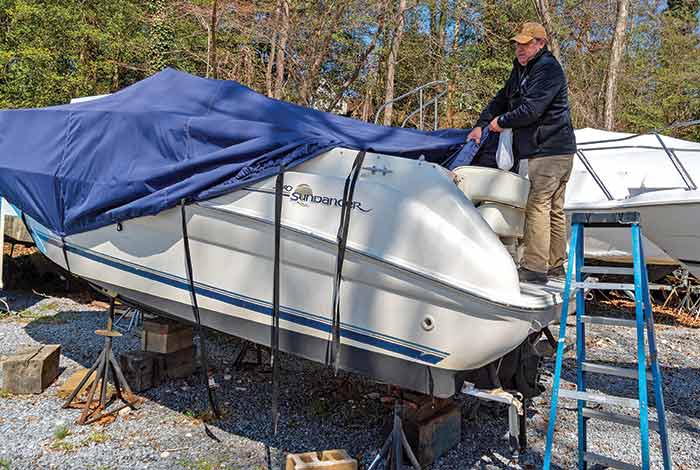
The marine tarp was the only option that was a candidate for a frame, but one wasn't used. Some covers from Eevelle (Eevelle.com, NationalBoatCover.com) had the option of a built-in support in the form of poles and strapping, called Ridgeline, which was used in some of the boats.
Foundation staff checked the boats every other week throughout the winter to readjust covers and straps as necessary. Even though the wear points were covered initially, sharp/wear points became evident as the covers settled. We also discovered that the straps and buckles would get "loaded" when water was sitting in the cover; most covers needed to be bailed out after rain or snow.
Takeaways And Lessons Learned
- Check your marina contract to ensure reusable covers are allowed over the winter. Some yards require shrinkwrap for boats in rack storage because the extra weight, if water pooled, could cause collapse.
- Waterproof or water resistant? Not the same! Stick with waterproof for boat-storage covers.
- Does the manufacturer offer an installation video? Follow the instructions.
- Read the warranty. Understand what is and isn't included for the cover you're purchasing. Most warranties are only good for one replacement, and only cover defective workmanship and materials (like seams coming apart or fabric not waterproof as claimed). You'll need to show proof that the cover was installed correctly (take photos). Damage from sharp edges, wind, heavy weather, and pooling generally isn't covered. In most cases, a warranty is only good for the person who buys the cover; it doesn't transfer if the boat is sold or if you buy a used cover.
- Enlist a helper. Covers can be heavy and awkward to handle. Have at least one other person to minimize the trips up and down the ladder and going side to side to adjust straps.
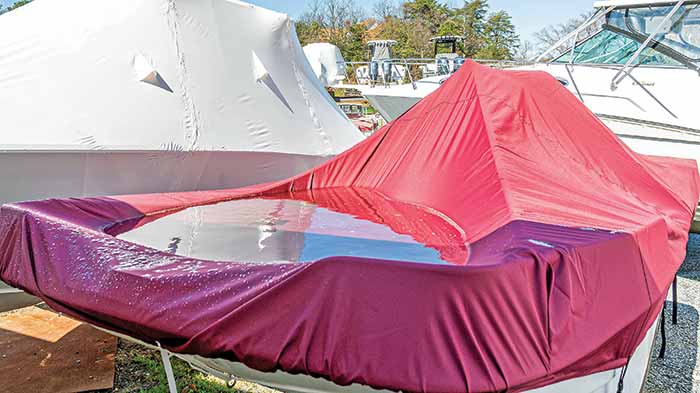
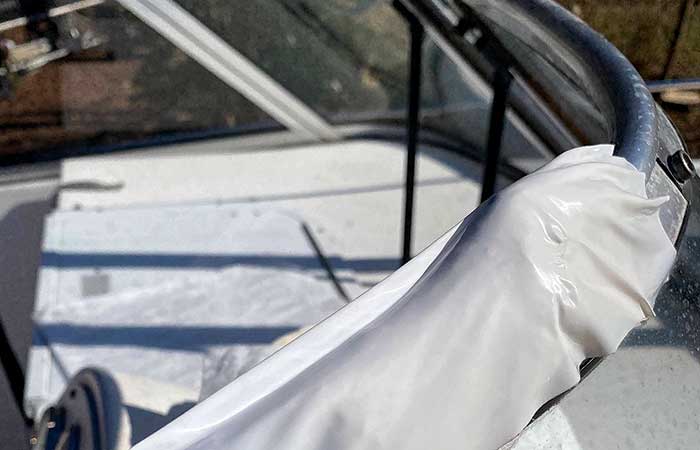
- Pad out corners and edges liberally. Pool noodles, old towels, and even sponges can be used on corners and sharp edges to reduce stress on the cover fabric as well as reduce rubbing at wear points on your boat. Don't forget the windscreen edges.
- Pad out support poles on both the bottom and top. Carpet squares can help spread the load and keep them from ripping through the cover or damaging your deck.
- Add nonskid (shelf liners would work) on the bottom base of the pole to keep it from sliding.
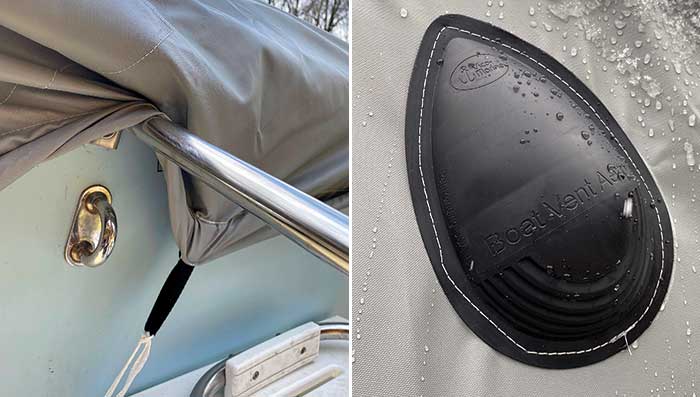
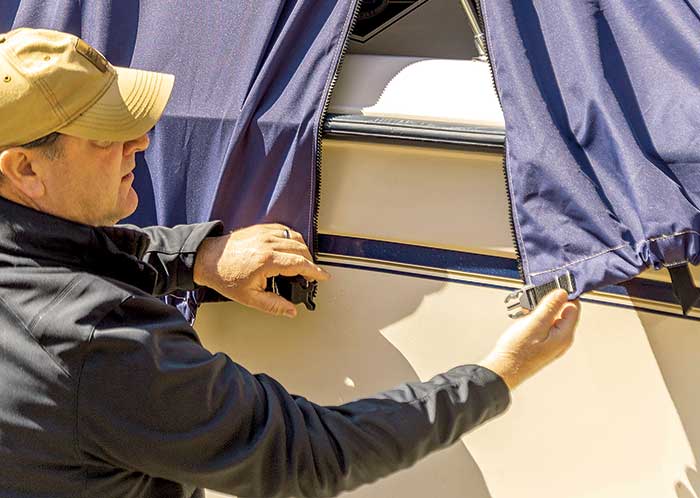
- Label the bow and stern and mark the centerline using permanent marker for easier installation next time.
- Label the cover with your name and your boat's name for easier identification. Once they're covered, boats in a boatyard or marina can be hard to tell apart!
- Never tie a cover to jackstands. In high winds or rain/snow, the tension can pull the supports out from under your boat. (This wasn't a lesson learned ... just useful info!)
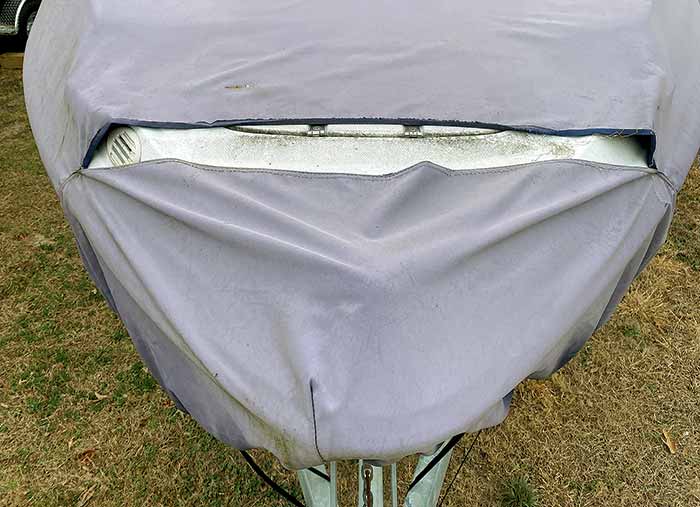
- Check your boat at least once a month, and after snow or heavy rains, throughout the off season. Get rid of any pooling water, which can cause damage to the boat, trailer, or lift from the extra weight, or cause the cover to rip.
- Clean according to manufacturer instructions and ensure the cover is completely dry before folding or rolling for seasonal storage.
Understanding Denier
When researching boat covers, you may see reference to the "denier" of the fabric used, especially those made from polyester (and sometimes polyethylene tarps). Generally, only polyester is described in denier, while acrylic is often described in ounces.
Denier is a unit of measurement for the thickness of individual threads used in the manufacture of fabrics or textiles. The higher the number, the coarser, sturdier, and more durable the fabric. The lower the number, the more sheer, soft, and silky the fabric. A 600D fabric is going to be twice as strong as 300D, and 1200D is twice as strong as 600D. Higher denier fabrics are heavier and more protective against the elements, such as rain, wind, and UV damage.
The Bottom Line
When it comes to covering boats for storage, there's no one-size-fits-all solution. In our experience, a strong tarp might do the trick for the budget-minded boater, if installed well and checked regularly. Custom covers are a good investment if you're going to own your boat for a few years. But the good-quality semi-custom covers offered the best balance between fit, durability, and value

